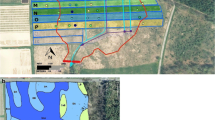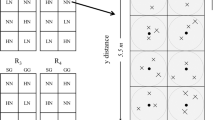Abstract
Information on temporal and spatial patterns of N mineralization is critical in designing tree-crop mixed systems that could maximize N uptake while minimizing N loss. We quantified N mineralization rates in a pecan (Carya illinoensis K. Koch)–cotton (Gossypium hirsutum L.) alley cropping system in northwestern Florida with (non-barrier) and without tree-crop belowground interactions (barrier separating the root systems of pecan and cotton). Monthly rates of mineralization were estimated using buried bag incubations over a 15-month period. In addition, seasonal mineralization rates and cotton lint yield on soils supplied with two sources of N—inorganic fertilizer and organic poultry litter—were assessed. Results indicated that temporal variations in net NH4 and NO3 accumulation and mineralization rates were driven primarily by environmental factors and to a lesser degree by initial soil NH4 and NO3 levels. Mineralization varied by belowground interaction treatment during the initial growing season, when the non-barrier treatment exhibited a higher mineralization rate than the barrier treatment, likely due to reduced nutrient uptake by cotton in the non-barrier or a higher degree of immobilization in the barrier treatment. Mineralization during the second growing season was similar for both treatments. Source of N had no effects on N transformation in the soil. Lint yield reductions were observed in the non-barrier treatment during both years compared to the barrier treatment, likely due to interspecific competition for water. Yield differences between treatments in the second growing season were likely compounded by a diminishing pre-study fallow effect. Source of N was found to have a significant effect on cotton yield, with inorganic fertilizer resulting in 39% higher lint compared to poultry litter in the barrier treatment.







Similar content being viewed by others
References
Allen SC, Jose S, Brecke BJ, Nair PKR, Ramsey CL (2004) Competition for nitrogen in a pecan (Carya illinoensis K. Koch)–cotton (Gossypium hirsutum L.) alley cropping system in the southern United States. Plant Soil (in press)
Bielek P (1998) Nitrate in nature: product of soil cover. Environ Pollut 102:527–530
Clein JS, Schimel JP (1995) Nitrogen turnover and availability during succession from alder to poplar in Alaskan taiga forests. Soil Biol Biochem 27:743–752
Deng SP, Tabatabai MA (2000) Effect of cropping systems on nitrogen mineralization in soils. Biol Fertil Soils 31:211–218
Eno CF (1960) Nitrate production in the field by incubating the soil in polyethylene bags. Soil Sci Soc Am Proc 24:277–279
Foster NW (1989) Influences of seasonal temperature on nitrogen and sulfur mineralization / immobilization in a maple-birch forest floor in central Ontario. Can J Soil Sci 69:501–514
Goncalves JLM, Carlyle JC (1994) Modelling the influence of moisture and temperature on net nitrogen mineralization in a forested sandy soil. Soil Biol Biochem 26:1557–1564
Hart SC, Stark JM, Davidson EA, Firestone MK (1994) Nitrogen mineralization, immobilization, and nitrification. In: Weaver RW, Angle JS, Bottomley PS (eds) Methods of soil analysis. Part 2: microbial and biochemical properties. Soil Science Society of America, Madison, Wis., pp 985–1018
Ikerra ST, Maghembe JA, Smithson PC, Buresh RJ (2001) Dry-season sesbania fallows and their influence on nitrogen availability and maize yields in Malawi. Agrofor Syst 52:13–21
Jose S, Gillespie AR, Seifert JR, Biehle DJ (2000a) Defining competition vectors in a temperate alley cropping system in the midwestern USA: 2. Competition for water. Agrofor Syst 48:41–59
Jose S, Gillespie AR, Seifert JR, Mengel DB, Pope PE (2000b) Defining competition vectors in a temperate alley cropping system in the midwestern USA: 3. Competition for nitrogen and litter decomposition dynamics. Agrofor Syst 48:61–77
Jose S, Gillespie AR, Pallardy SG (2004) Interspecific interactions in temperate agroforestry. Agrofor Syst 61:237–255
Kaur B, Gupta SR, Singh G (2000) Soil carbon, microbial activity and nitrogen availability in agroforestry systems on moderately alkaline soils in northern India. Appl Soil Ecol 15:283–294
Keeney D, Nelson D (1982) Nitrogen—inorganic forms. In: Page A, Miller R, Keeney D (eds) Methods of soil analysis. Part 2: chemical and microbiological properties, 2nd edn. American Society of Agronomy, Madison, Wis., pp 643–698
Kwesiga F, Coe R (1994) The effect of short rotation Sesbania sesban planted fallow on maize yield. For Ecol Manage 64:199–208
Lee KH, Jose S (2003) Soil respiration and microbial biomass in a pecan–cotton alley cropping system in southern USA. Agrofor Syst 58:45–54
Little TM, Hills FJ (1978) Agricultural experimentation. Wiley, New York
Lovell RD, Hatch DJ (1998) Stimulation of microbial activity following spring applications of nitrogen. Biol Fertil Soils 26:28–30
Maithani K, Arunachalam A, Tripathi RS, Pandey HN (1998) Nitrogen mineralization as influenced by climate, soil and vegetation in a subtropical humid forest in northeast India. For Ecol Manage 109:91–101
Malik RK, Reddy KC (2001) Effects of nitrification inhibitor on nitrate leaching in cotton production systems. In: Stott DE, Mohtar RH, Steinhardt GD (eds) Sustaining the global farm—selected papers from the 10th International Soil Conservation Organization Meeting. International Soil Conservation Organization, West Lafayette, Ind., pp 371–377
Maroko JB, Buresh RJ, Smithson PC (1998) Soil nitrogen availability as affected by fallow-maize systems on two soils in Kenya. Biol Fertil Soils 26:229–234
Mary B, Beaudoin N, Justes E, Machet JM (1999) Calculation of nitrogen mineralization and leaching in fallow soil using a simple dynamic model. Eur J Soil Sci 50:549–566
Menezes RSC, Salcedo IH, Elliott ET (2002) Microclimate and nutrient dynamics in a silvopastoral system of semiarid northeastern Brazil. Agrofor Syst 56:27–38
Mitchell CC, Donald JO (1999) The value and use of poultry manures as fertilizer. Publication ANR-244. Alabama Cooperative Extension Service, Alabama A&M University, Auburn University, Auburn, Ala.
Mitchell CC, Burmester CH, Wood CW and Edmisten KL (1992) Broiler litter on cotton: 1990 and 1991 test/demonstration results. New technical demonstration report no. S-03-92. Alabama Cooperative Extension Service, Alabama A&M University, Auburn University, Auburn, Ala.
Nair PKR (1987) Soil productivity under agroforestry. In: Gholz HL (ed) Agroforestry: realities, possibilities and potentials. Nijhoff, Dordrecht, pp 21–30
Noble AD, Randall PJ (1998) How trees affect soils—a report for the Rural Industries Research and Development Corporation (RIRDC). Publication no. 98/16. RIRCD, Barton, ACT, Australia
Nyakatawa EZ, Reddy KC, Mays DA (2000) Tillage, cover cropping, and poultry litter effects on cotton: II. Growth and yield parameters. Agron J 92:1000–1007
O’Connell AM, Rance SJ (1999) Predicting nitrogen supply in plantation eucalypt forests. Soil Biol Biochem 31:1943–1951
Palm CA (1995) Contribution of agroforestry trees to nutrient requirements of intercropped plants. Agrofor Syst 30:105–124
Palm CA, Sanchez PA (1991) Nitrogen release from the leaves of some tropical legumes as affected by their lignin and polyphenolic contents. Soil Biol Biochem 23:83–88
Pérez CA, Hedin LO, Armesto JJ (1998) Nitrogen mineralization in two unpolluted old-growth forests of contrasting biodiversity and dynamics. Ecosystems 1:361–373
Priha O, Smolander A (1999) Nitrogen transformations in soil under Pinus sylvestris, Picea abies and Betula pendula at two forest sites. Soil Biol Biochem 31:965–977
Reich PB, Grigal DF, Aber JD, Gower ST (1997) Nitrogen mineralization and productivity in 50 hardwood and conifer stands on diverse soils. Ecology 78:335–347
Reynolds PE, Thevathasan NV, Simpson JA, Gordon AM, Lautenschlager RA, Bell WF, Gresch DA, Buckley DA (2000) Alternative conifer release treatments affect microclimate and soil nitrogen mineralization. For Ecol Manage 133:115–125
Seiter S, Horwath WR (1999) The fate of tree root and pruning nitrogen in a temperate climate alley cropping system determined by tree-injected 15N. Biol Fertil Soils 30:61–68
Thevathasan NV, Gordon AM (1997) Poplar leaf biomass distribution and nitrogen dynamics in a poplar-barley intercropped system in southern Ontario, Canada. Agrofor Syst 37:79–90
Wanvestraut R, Jose S, Nair PKR, Brecke BJ (2004) Competition for water in a pecan–cotton alley cropping system. Agrofor Syst 60:167–179
Acknowledgements
The authors thank H. Adegbidi, C. Allen, S. Claypool, B. Hahr, C. Hardin, D. Hatfield, K. Lee, J. Liddle, L. McCue, S. Merritt, J. Nelson, L. White and D. Zamora, for their help with data collection and sample preparation. This study was funded in part by two grants from the USDA Southern Region Sustainable Agriculture Research and Education program (nos. GS01-009 and LS02-136), and by a grant from USDA-IFAFS (no. 00-52103-9702) through the Center for Subtropical Agroforestry at the University of Florida. Florida Agricultural Experiment Station Journal Series no. R-09610.
Author information
Authors and Affiliations
Corresponding author
Rights and permissions
About this article
Cite this article
Allen, S.C., Jose, S., Nair, P.K.R. et al. Nitrogen mineralization in a pecan (Carya illinoensis K. Koch)–cotton (Gossypium hirsutum L.) alley cropping system in the southern United States. Biol Fertil Soils 41, 28–37 (2005). https://doi.org/10.1007/s00374-004-0799-2
Received:
Revised:
Accepted:
Published:
Issue Date:
DOI: https://doi.org/10.1007/s00374-004-0799-2




